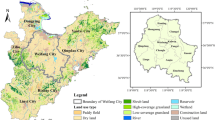Abstract
Context
The major goal of ecological security patterns (ESPs) is to identify key ecological sources and corridors, which play an important role in achieving regional sustainability. Although an increasing number of reviews have been published on constructing ESPs, reasonably prioritizing ecological corridors to maintain vital ecological processes and landscape connectivity remains a challenge.
Objective
This study aimed to provide guidance for landscape management and decision making by developing an evaluation framework to construct ESPs and further prioritize potential corridors.
Methods
Taking Jiangsu Province as a study area, we identified ecological sources by considering three key ecosystem services (biodiversity, carbon storage and water yield) and three ecological sensitivity indicators (soil erosion sensitivity, water sensitivity and habitat sensitivity) using the InVEST model, RULSE model and GIS spatial overlay analysis. Then, ecological corridors were delineated with the least-cost path method, and the ESPs were obtained by combining these corridors with ecological sources. We further prioritized ecological corridors based on the gravity model and the probability of connectivity index.
Results
The ESPs of Jiangsu Province contained 51 patches and 37 corridors. The total area of the ecological patches was 15,170.51 km2, accounting for 14.61% of the study area and primarily consisting of water bodies, cropland and forestland. Ecological corridors comprised 1920.38 km and were divided into four quadrants via a precedence matrix. The sixteen ecological corridors in the first quadrant (high importance and strong connectivity) were defined as priority areas and occupied 39.50% of the total corridor length.
Conclusion
Our methodology framework offers a valuable tool for constructing ESPs and prioritizing corridors at the regional scale. This framework incorporates targeted ecosystem services and ecological vulnerability indicators to systematically assess and identify key ecological space. The conservation of ecological corridors selected in light of their importance and contribution to enhancing connectivity is a more targeted measure. It could be applied to other landscapes and geographical contexts.







Similar content being viewed by others
References
Adriaensen F, Chardon JP, Blust GD et al (2003) The application of 'least-cost' modelling as a functional landscape model. Landscape Urban Plan 64(4):233–247
Avon C, Bergès L (2016) Prioritization of habitat patches for landscape connectivity conservation differs between least-cost and resistance distances. Landscape Ecol 31(7):1551–1565
Blazquez-Cabrera S, Ciudad C, Gastón A, Simón MÁ, Saura S (2018) Identification of strategic corridors for restoring landscape connectivity: application to the Iberian lynx. Anim Conserv 22(3):210–219
Dabelko GD, Dabelko DD (1995) Environmental security: issues of conflict and redefinition. Environ Change Security Project Report 1(1):3–13
Esbah H, Cook EA, Ewan J (2009) Effects of increasing urbanization on the ecological integrity of open space preserves. Environ Manage 43(5):846–862
Foltête JC, Berthier K, Cosson JF (2008) Cost distance defined by a topological function of landscape. Ecol Model 210(1–2):104–114
Forman R (1983) Corridors in a landscape: their ecological structure and function. Ekologia 2(4):375–387
Forman R, Godron M (1981) Patches and structural components for a lanscape ecology. Bioscience 31:733–740
Gaston KJ (2000) Global patterns in biodiversity. Nature 405(6783):220–227
Guo R, Wu T, Liu M, Huang M, Stendardo L, Zhang Y (2019) The construction and optimization of ecological security pattern in the Harbin-Changchun urban agglomeration, China. Int J Environ Res Public Health 16(7):1–18
Harris LD, Scheck J (1991) From implications to applications : the dispersal corridor principle applied to the conservation of biological diversity. Nat Conserv 60(2):189–220
Hepcan CC, Ozkan MB (2011) Establishing ecological networks for habitat conservation in the case of CeAYme-Urla Peninsula. Turkey Environ Monit Assess 174(1–4):157–170
Jia XQ, Fu BJ, Feng XM, Hou GH, Liu Y (2014) The tradeoff and synergy between ecosystem services in the Grain-for-Green areas in Northern Shaanxi, China. Ecol Ind 43:103–113
Jordán F, Báldi A, Orci KM, Rácz I, Varga Z (2003) Characterizing the importance of habitat patches and corridors in maintaining the landscape connectivity of a Pholidoptera transsylvanica(Orthoptera) metapopulation. Landscape Ecol 18(1):83–92
Knaapen JP, Scheffer M, Harms B (1992) Estimating habitat isolation in landscape planning. Landscape Urban Plan 23(1):1–16
Kong F, Yin H, Nakagoshi N, Zong Y (2010) Urban green space network development for biodiversity conservation: identification based on graph theory and gravity modeling. Landscape Urban Plan 95(1–2):16–27
Kouli M, Soupios P, Vallianatos F (2009) Soil erosion prediction using the Revised Universal Soil Loss Equation (RUSLE) in a GIS framework, Chania, Northwestern Crete. Greece Environ Geol 57(3):483–497
Li YU (2011) Species abundance and distribution patterns of endangered terrestrial vertebrates in Jiangsu Province. J Ecol Rural Environ 27(4):32–39
Li Y, Sun X, Zhu X, Cao H (2010) An early warning method of landscape ecological security in rapid urbanizing coastal areas and its application in Xiamen. China Ecol Model 221(19):2251–2260
Liquete C, Kleeschulte S, Dige G et al (2015) Mapping green infrastructure based on ecosystem services and ecological networks: a Pan-European case study. Environ Sci Policy 54:268–280
Liu Y (2018) Introduction to land use and rural sustainability in China. Land Use Policy 74:1–4
Long JA (2019) Estimating wildlife utilization distributions using randomized shortest paths. Landscape Ecol 34(11):2509–2521
Mao D, Wang, et al (2018) China's wetlands loss to urban expansion. Land Degrad Dev 29(8):2644–2657
Mcneely JA (1990) How conservation strategics contribute to sustainable development. Environ Conserv 17(1):9–13
Mcrae BH, Dickson BG, Keitt TH, Shah VB (2008) Using circuit theory to model connectivity in ecology, evolution, and conservation. Ecology 89(10):2712–2724
Mike H, Simon M (2009) 'Urban Ecological Security': a new urban paradigm? Int J Urban Reg Res 33(1):193–215
Minor ES (2007) Graph theory as a proxy for spatial explicit population models in conservation planning. Ecol Appl 17(6):1771–1782
Nelson E, Mendoza G, Regetz J et al (2009) Modeling multiple ecosystem services, biodiversity conservation, commodity production, and tradeoffs at landscape scales. Front Ecol Environ 7(1):4–11
Pascual-Hortal L, Saura S (2006) Comparison and development of new graph-based landscape connectivity indices: towards the priorization of habitat patches and corridors for conservation. Landscape Ecol 21(7):959–967
Peng J, Yang Y, Xie P, Liu YX (2017) Zoning for the construction of green space ecological networks in Guangdong province based on the supply and demand of ecosystem services. Acta Ecol Sin 37(13):4562–4572
Peng J, Li H, Liu Y, Hu Y, Yang Y (2018a) Identification and optimization of ecological security pattern in Xiong'an New Area. Acta Geogr Sin 73(4):701–710
Peng J, Pan Y, Liu Y, Zhao H, Wang Y (2018b) Linking ecological degradation risk to identify ecological security patterns in a rapidly urbanizing landscape. Habitat International 71:110–124
Peng J, Yang Y, Liu Y et al (2018c) Linking ecosystem services and circuit theory to identify ecological security patterns. Sci Total Environ 644:781–790
Peng J, Wang A, Luo L et al (2019) Spatial identification of conservation priority areas for urban ecological land: an approach based on water ecosystem services. Land Degrad Dev 30(6):683–694
Pinto N, Keitt TH (2009) Beyond the least-cost path: evaluating corridor redundancy using a graph-theoretic approach. Landscape Ecol 24(2):253–266
Qiu J, Turner MG (2013) Spatial interactions among ecosystem services in an urbanizing agricultural watershed. Proc Natl Acad Sci USA 110(29):12149–12154
Rayfield B, Fortin MJ, Fall A (2010) The sensitivity of least-cost habitat graphs to relative cost surface values. Landscape Ecol 25(4):519–532
Saura S, Pascual-Hortal L (2007) A new habitat availability index to integrate connectivity in landscape conservation planning: comparison with existing indices and application to a case study. Landscape Urban Plan 83(2–3):91–103
Saura S, Rubio L (2010) A common currency for the different ways in which patches and links can contribute to habitat availability and connectivity in the landscape. Ecography 33(3):523–537
Saura S, Bastin L, Battistella L, Mandrici A, Dubois G (2017) Protected areas in the world’s ecoregions: how well connected are they? Ecol Ind 76:144–158
Savage AM, Hackett B, Guénard B, Youngsteadt EK, Dunn RR (2015) Fine-scale heterogeneity across Manhattan's urban habitat mosaic is associated with variation in ant composition and richness. Insect Conserv Divers 8(3):216–228
Sharp R, Tallis H, Ricketts T, Guerry T, Wood SA (2018) InVEST 3.7.0. The Natura Capital Project, Stanford University, University of Minnesota, The Nature Conservancy, and World Wildlife Fund
Sirakaya A, Cliquet A, Harris J (2017) Ecosystem services in cities: towards the international legal protection of ecosystem services in urban environments. Ecosystem Services 29:205–212
Soule M, E. (1991) Conservation: tactics for a constant crisis. Science 253(5021):744–750
Steffen W, Richardson K, Rockstrom J et al (2015) Planetary boundaries: guiding human development on a changing planet. Science 347(6223):1259855
Sun W, Chen W, Chen C, Gao S, Guo Y (2011) Constraint regionalization of water environment and the guidance for industrial layout: a case study of Jiangsu Province. J Geog Sci 21(5):937–948
Taylor PD, Fahrig L, Merriam HG (1993) Connectivity is a vital element of landscape structure. Oikos 68(3):571–573
Théau J, Bernier A, Fournier RA (2015) An evaluation framework based on sustainability-related indicators for the comparison of conceptual approaches for ecological networks. Ecol Ind 52:444–457
Williams JC, Snyder SA (2005) Restoring habitat corridors in fragmented landscapes using optimization and percolation models. Environ Model Assess 10(3):239–250
Wu J (2013) Key concepts and research topics in landscape ecology revisited: 30 years after the Allerton Park workshop. Landscape Ecol 28(1):1–11
Wu J (2014) Urban ecology and sustainability: the state-of-the-science and future directions. Landscape Urban Plan 125:209–221
Wu J, Jelinski DE, Luck M, Tueller PT (2000) Multiscale analysis of landscape heterogeneity: scale variance and pattern metrics. Geogr Inf Sci 6(1):6–19
Wu Y, Tao Y, Yang G et al (2019) Impact of land use change on multiple ecosystem services in the rapidly urbanizing Kunshan City of China: Past trajectories and future projections. Land Use Policy 85:419–427
Xu L, You H, Li D, Yu K (2016) Urban green spaces, their spatial pattern, and ecosystem service value: the case of Beijing. Habitat Int 56:84–95
Xu X, Yang G, Tan Y (2019) Identifying ecological red lines in China's Yangtze River Economic Belt: a regional approach. Ecol Ind 96:635–646
Yimin LI, Guan C, Zhu J (2017) GIS-based ecological sensitivity analysis in Xingyun Lake Basin. Res Soil Water Conserv 24(5):266–278
Yimin L, Chengwen G, Liqin G, Jun Z, Yaping D, Yaya X (2018) Optimization of land use spatial pattern in Jiangchuan district based on ecological sensitivity analysis. Trans Chin Soc Agric Eng 34(20):267–276
Yu K (1996) Security patterns and surface model in landscape ecological planning. Landscape Urban Plan 36(1):0–17
Zhang H, Gao JX, Ma MX, Shao FZ, Zhou KX (2017) Influence of road on breeding habitat of Nipponia nippon based on MaxEnt model. Chin J Appl Ecol 28(4):1352–1359
Zhou B-B, Wu J, Anderies JM (2019) Sustainable landscapes and landscape sustainability: a tale of two concepts. Landscape Urban Plan 189:274–284
Zhu Q, Kong Jian YU, Di Hua LI (2005) The width of ecological corridor in landscape planning. Acta Ecol Sin 25(9):2406–2412
Acknowledgments
The authors acknowledge the support from the Ministry of Science and Technology, China (2018YFD1100103), the 111 project, China (B17024), the National Natural Science Foundation of China (71774085, 71774086), the Chinese Academy of Sciences (XDA23020201), and the Postgraduate Research & Practice Innovation Program of Jiangsu Province (KYCX19_0598).
Author information
Authors and Affiliations
Corresponding authors
Additional information
Publisher's Note
Springer Nature remains neutral with regard to jurisdictional claims in published maps and institutional affiliations.
Shancai Xiao and Wenjun Wu are the co-first authors of this work.
Electronic supplementary material
Below is the link to the electronic supplementary material.
Rights and permissions
About this article
Cite this article
Xiao, S., Wu, W., Guo, J. et al. An evaluation framework for designing ecological security patterns and prioritizing ecological corridors: application in Jiangsu Province, China. Landscape Ecol 35, 2517–2534 (2020). https://doi.org/10.1007/s10980-020-01113-6
Received:
Accepted:
Published:
Issue Date:
DOI: https://doi.org/10.1007/s10980-020-01113-6




